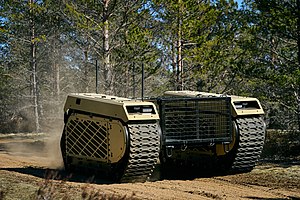Integrated Unmanned Ground System
| Integrated Unmanned Ground System | |
|---|---|
 THeMIS that will be used as basis for the iMUGS (not representative of the final iMUGS design) | |
| Type | Unmanned ground vehicle |
| Place of origin | |
| Service history | |
| Used by |
|
| Production history | |
| Manufacturer | |
| Produced | Demonstration planned 2021 |
Integrated Modular Unmanned Ground System (UGS or iMUGS) is a European Union's Permanent Structured Cooperation (PESCO) project that aims to create a European standard unmanned ground system and develop scalable modular architecture for hybrid manned-unmanned systems, as well as increasing interoperability, situational awareness and speeding up decision making. The project is coordinated by Estonia, with 10 other European countries participating. It will use Milrem's existing THeMIS unmanned ground vehicle for different payloads.[1][2][3]
The total cost of the programme is €32.6m, of which €30.6m was funded by the European Commission (EDIDP) and the remaining €2m by the participating countries collectively. The aim of the EDIDP programme is to strengthen the strategic autonomy of the European Union and the co-operation between member countries.[4][5]
The project results will be shown in operational environments as part of military exercises or at separate testing events, the first demonstration is scheduled for Q2 2021 in Estonia, with later demonstrations planned in each member state.[6] In October 2022 the project was demonstrated in french Versailles. Unmanned, autonomous groundsystems where performing a diversity of defence missions, such as reconnaissance, evacuation and replenishment. Safran and Nexter were leading the presentation. [7] Further demonstrations were held in german Lehnin in December of that year.[8]
Objectives
[edit]Goal of the project is to build and demonstrate a system of unmanned ground and airborne vehicles that can perform a variety of surveillance and rescue tasks and standardise a European ecosystem for aerial and ground platforms, command, control and communications, sensors, payloads, and algorithms.[9] The ethical aspects of robotics, artificial intelligence, and autonomous systems will be taken into account, Milrem said the system being developed would be under “meaningful human control”.[10]
Requirements set by 7 members:[11]
- Autonomy
- Cyber Security
- Communications & Vehicle to vehicle
- Command & Control, Interoperability
- Modular Standardized Open Architecture
- Swarming
- Manned-Unmanned Teaming & Operational Scenarios
Capabilities:
- Multi-mission capable platform to carry different payloads (transport, ISR, tethered UAV etc.) and sensors
- Cyber secure autonomous navigation capability for route and mission planning with different options for manned-unmanned teaming
- EW resilient Command & Control interface capable of swarming and interoperable with existing C4 systems
Members
[edit]Participating companies
[edit]14 companies from across Europe are cooperating on the project:[12]
 Milrem Robotics
Milrem Robotics GT Cyber Technologies
GT Cyber Technologies Estonian Military Academy
Estonian Military Academy Safran Electronics & Defense
Safran Electronics & Defense NEXTER Systems
NEXTER Systems Krauss-Maffei Wegmann
Krauss-Maffei Wegmann Diehl Defence
Diehl Defence Latvijas Mobilais Telefons
Latvijas Mobilais Telefons Bittium
Bittium Insta DefSec
Insta DefSec GMV Aerospace and Defence will be coordinator of the command and control and C4ISR interoperability subproject[13]
GMV Aerospace and Defence will be coordinator of the command and control and C4ISR interoperability subproject[13] (UN)MANNED will develop the certifiable ground control station allowing one operator to control a large fleet of unmanned systems (Unmanned Aerial Vehicles and Unmanned Ground Vehicles).
(UN)MANNED will develop the certifiable ground control station allowing one operator to control a large fleet of unmanned systems (Unmanned Aerial Vehicles and Unmanned Ground Vehicles). Royal Military Academy of Belgium will lead the sub-project on swarming, developing capabilities, enabling heterogeneous teams of robots to work as a group towards a common objective.
Royal Military Academy of Belgium will lead the sub-project on swarming, developing capabilities, enabling heterogeneous teams of robots to work as a group towards a common objective. dotOcean is member of the swarming team and develops algorithms to enable teamwork and cooperation in a fleet of networked robots.[14]
dotOcean is member of the swarming team and develops algorithms to enable teamwork and cooperation in a fleet of networked robots.[14]
See also
[edit]References
[edit]- ^ "integrated-unmanned-ground-system-ugs".
- ^ Hankewitz, Sten (2020-12-18). "Estonia-led consortium to develop the European standard unmanned ground system". Estonian World. Retrieved 2021-02-12.
- ^ "EU States Come Together to Develop A Modular UGV". www.defenceprocurementinternational.com. Retrieved 2021-02-12.
- ^ "Press corner". European Commission - European Commission. Retrieved 2021-02-12.
- ^ "integrated modular unmanned ground system" (PDF). European Commission. 2019.
- ^ MariaTiidus (2020-12-16). "Estonia led consortium to start the development of the European standard unmanned ground system > Centre for Defence Investment". Centre for Defence Investment. Retrieved 2021-02-12.
- ^ redaktion, spartanat (2022-12-13). "iMUGS: Hier kommt THeMIS UGV". SPARTANAT (in German). Retrieved 2023-04-04.
- ^ KG, Diehl Stiftung & Co. "iMUGS-Demonstration in Lehnin | Diehl Defence". www.diehl.com (in German). Retrieved 2023-04-04.
- ^ "Milrem-led consortium receives EU grant to develop European standard unmanned ground system". Janes.com. Retrieved 2021-02-12.
- ^ "Milrem Robotics led consortium to start the development of the European standard unmanned ground system". Milrem. 2020-12-16. Retrieved 2021-02-12.
- ^ "Milrem Robotics led consortium awarded 30,6 MEUR by the European Commission to develop a European standardized unmanned ground system". Milrem. 2020-06-17. Retrieved 2021-02-12.
- ^ Richardson, Jack (2020-06-23). "Development of a European Standardised Unmanned Ground System". European Security & Defence. Archived from the original on 2021-05-11. Retrieved 2021-02-12.
- ^ "GMV | unmanned ground vehicle". www.gmv.com. Retrieved 2021-02-12.[permanent dead link]
- ^ "dotOcean contributes to the future of an European standard unmanned ground system • dotOcean". dotOcean. 2020-12-22. Retrieved 2021-02-12.
